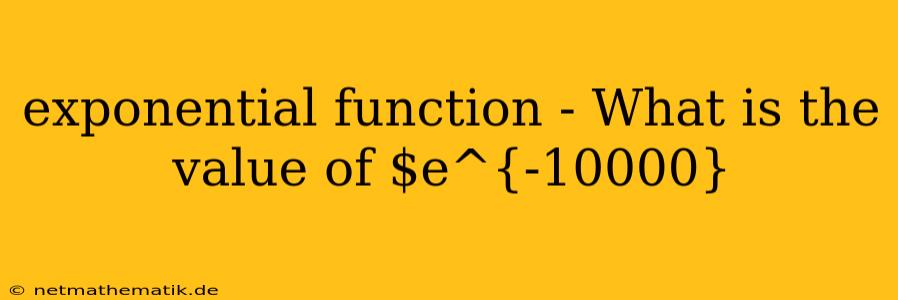The exponential function, denoted as e^x, is a fundamental mathematical concept with widespread applications in various fields, including physics, engineering, finance, and biology. It is characterized by its rapid growth or decay, depending on the value of the exponent. In this article, we will delve into the intricacies of the exponential function and explore the specific case of e^-10000, a value that may seem daunting at first glance.
Understanding the Exponential Function
The exponential function e^x is defined as the limit of (1 + 1/n)^n as n approaches infinity. It is a transcendental function, meaning that it cannot be expressed as a finite combination of algebraic operations and constants. However, its properties and behavior are well-defined and can be explored through calculus and numerical methods.
One of the key characteristics of the exponential function is its constant rate of change. This means that the rate of growth or decay of the function is proportional to its current value. For instance, if the value of e^x doubles every unit increase in x, then it will continue to double at the same rate for any value of x. This constant rate of change is a key factor in its numerous applications in modeling natural phenomena, such as population growth, radioactive decay, and compound interest.
The Significance of e
The constant e, approximately equal to 2.71828, holds a special place in mathematics and has far-reaching implications. It arises naturally in many areas of mathematics, such as calculus, probability, and statistics. Its significance lies in its connection to the exponential function and its ability to represent continuous growth or decay.
For instance, in calculus, the derivative of e^x is simply e^x itself. This property makes e^x a particularly important function in differential equations, where it is often used to model processes that involve continuous change. In probability, the exponential function is used to define the Poisson distribution, which is a widely used model for random events occurring independently over a given time interval.
The Value of e^-10000
Now, let's turn our attention to the specific value of e^-10000. This seemingly small value, often encountered in applications involving very small probabilities or rates of decay, requires careful consideration due to the nature of the exponential function.
Since the exponent is negative, e^-10000 represents the reciprocal of e^10000. As the exponent increases, the value of e^x grows exponentially large. Consequently, the reciprocal, e^-10000, will be extremely small, approaching zero as the exponent becomes very large.
Approximating the Value
While calculating the exact value of e^-10000 is computationally challenging, we can use numerical methods to approximate it. Scientific calculators and computer software provide tools for calculating exponential functions to high precision. However, even with these tools, the resulting value will be extremely small, likely expressed in scientific notation with a very large negative exponent.
For instance, using a calculator, we might obtain an approximation like:
e^-10000 ≈ 1.928749848 × 10^-4343
This result indicates that e^-10000 is a tiny fraction of 1, representing a value that is practically zero for all practical purposes.
Applications of Extremely Small Values
Despite their minute size, values like e^-10000 play crucial roles in various scientific and engineering domains. For instance, in physics, they are used to model the probabilities of rare events, such as the decay of radioactive isotopes. In computer science, they are used to represent probabilities in machine learning algorithms, where the likelihood of certain events can be extremely small.
Moreover, in financial modeling, these values can be used to represent the discounted value of future cash flows, where the discounting factor accounts for the time value of money and the uncertainty associated with future events.
Conclusion
The exponential function e^x is a powerful mathematical tool with wide-ranging applications in numerous fields. The value of e^-10000, while seemingly insignificant, highlights the remarkable ability of the exponential function to represent both extremely large and infinitesimally small values. Understanding its behavior and applications is crucial for comprehending complex phenomena in fields such as physics, engineering, and finance.
